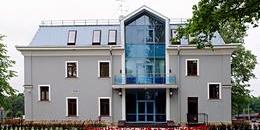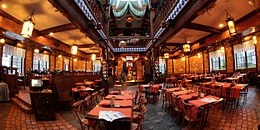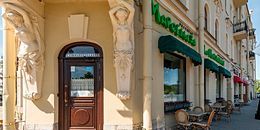Krestovsky Island (Island of the Cross)
Krestovsky Island is the largest of the three Kirov Islands, which stand north of the Petrograd Side in the Neva delta. It has for centuries been a popular playground for the general populace of St. Petersburg, with much of the island common ground from the beginning of the 19th century. Today it is rapidly turning into the city's smartest suburb, with an ever-increasing number of elite housing developments encroaching on the public park. However, it still attracts hordes of visitors at weekends, coming to walk through the island's rambling parkland, take advantage of the numerous sporting facilities available, or to visit the Divo Ostrov amusement park.
The exact origin of the name Krestovsky Island is contested. One school of thought links the name to the cross-shaped lake that can apparently be found on the island, while others claim that a large cross was found on the island at some point in history. The third suggestion connects the name to the chapel on the island that is mentioned in records from the 16th century. On Swedish maps dating back to before the founding of St. Petersburg, the island is marked Riisti-Saari - "Cross Island" in Finnish.
Krestovsky Island, like its neighbours Yelagin Island and Kamenny Island, was in 1710 presented by Peter the Great to one of his closest allies, in this case Prince Alexander Menshikov. Soon after, it was handed to Peter's sister, Tsareevna Natalia Alekseevna and, on a map of St. Petersburg, from 1717 it is marked "Island of St. Natalia". Just over a decade later, the island was given to Count Burkhard Christoph Von Münnich, the German-born soldier and statesmen who was one of Peter's last favourites, and retained his prominent position in Russian military and state affairs through the reign of Empress Anna. In his lifetime the island was known as Khristoforov Ostrov. When Elizabeth came to the throne, the island was handed to her favourite, Alexei Razumovsky, in whose family it stayed until bought by the Beloselsky-Belozersky family, who retained an estate there until the October Revolution.

In the 19th century, the island became popular with the regular citizens of St. Petersburg, and amusements such as boating, swings, and several open-air restaurants were laid on for them. During the Soviet period, the island continued as a popular weekend destination for Leningraders, who were also drawn to the increasingly developed sports facilities on the island, starting with the Dinamo Stadium from 1925. This was followed by the vast Kirov Stadium, on the western half of the island, which was the original home of FC Zenit, St. Petersburg's premier soccer team. The 75,000-seat stadium, which is made mostly of mud from the bed of the Gulf of Finland, is scheduled for destruction to make way for a European-standard home for the increasingly successful Zenit. Nearby there is a small motor-racing track.
The Krestovsky (former Kirov) Stadium is at the far end of the island, in the Primorsky Victory Park, one of two memorial parks created directly after the Second World War to celebrate victory and honour those who died in the siege of Leningrad. Both parks were laid out entirely by volunteer members of the general public.

Modern Krestovsky Island, with its lack of historical sights, is probably of more appeal to locals than to visitors, but it is one of the best places in the city to bring children, who are well catered for on the island with the Divo Ostrov amusement park and the Dolphinarium, and it has the extra advantage of being easily accessed by metro. There are also a few good restaurants on the island, echoing 19th century traditions, and a very wide range of sports facilities.












